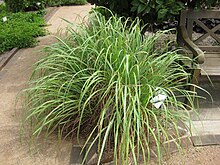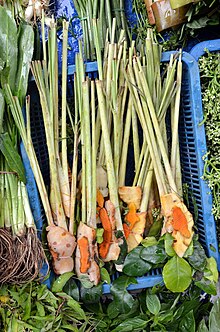Cymbopogon citratus
| Lemon grass | |
|---|---|

| |
| Scientific classification | |
| Kingdom: | Plantae |
| Clade: | Tracheophytes |
| Clade: | Angiosperms |
| Clade: | Monocots |
| Clade: | Commelinids |
| Order: | Poales |
| Family: | Poaceae |
| Subfamily: | Panicoideae |
| Genus: | Cymbopogon |
| Species: | C. citratus
|
| Binomial name | |
| Cymbopogon citratus | |
| Synonyms[2] | |
|
List
| |
Cymbopogon citratus,commonly known asWest Indian lemon grassor simplylemon grass,[3]is a tropicalplantnative toMaritime Southeast Asiaand introduced to many tropical regions.[4]
Cymbopogon citratusis often sold in stem form. While it can be grown in warmer temperate regions, such as the UK, it is nothardyto frost.
Morphology[edit]
Cymbopogon citratusis part of the grass family,Poaceae.They contain simple, bluish-green leaves with entire margins and are linear in shape. The blades tend to be 18–36 inches long. Like other grasses, the leaves also have parallel venation.[5]
Distribution[edit]
Cymbopogon citratusis native toIsland Southeast Asia(Malesia). It has been introduced extensively toSouth Asiasince precolonial times. AfterWorld War I,lemongrass was introduced toMadagascar,South America,andCentral America.It has now been naturalized throughout the tropics and subtropics worldwide.[6]
In its native range,Cymbopogon citratusis known assereh,serai,orserai dapurinIndonesiaandMalaysia;andtanglad(fromProto-Austronesian*Caŋelajoriginally referring toThemeda gigantea,a type of elephant grass[7]),salai,orbaliokoin thePhilippines.[6]
Culinary uses[edit]


Cymbopogon citratusis abundant in thePhilippinesandIndonesiawhere it is known astangladorsereh,respectively. Its fragrant leaves are traditionally used in cooking, particularly forlechonand roasted chicken.[8]
The dried leaves can also be brewed into a tea, either alone or as a flavoring in other teas, imparting a flavor reminiscent of lemon juice but with a mild sweetness without significant sourness or tartness.
InSri Lanka,lemongrass is known assera(සේර). It is used as a herb in cooking, in addition to its use for the essential oils.[9]
Lemongrass in Thailand is calledtakhrai(ตะไคร้). It is the essential ingredient oftom yamandtom kha kai.Fresh thin slices of lemongrass stem are also used in the snack foodmiangpla.
Medicinal uses[edit]
This sectionneeds morereliable medical referencesforverificationor relies too heavily onprimary sources.(December 2015) |  |
The leaves ofCymbopogon citratushave been used in traditional medicine and are often found in herbal supplements and teas. Evidence of effectiveCymbopogon citratusessential oil anti-protozoa activity againstLeishmania amazonensis.[10]
Chemical composition[edit]
Lemon grass oil contains 65–85%citralin addition tomyrcene,citronellal,citronellol,linaloolandgeraniol.[11][12]Hydrosteam distillation, condensation, and cooling can be used to separate the oil from the water. Thehydrosol,as aby-productof the distillation process, is used for the production of skin care products such as lotions, creams, and facial cleansers. The main ingredients in these products are lemon grass oil and "negros oil" (mixture of lemon grass oil withvirgin coconut oil) used inaromatherapy.[13]
Citronellolis an essential oil constituent fromCymbopogon citratus,Cymbopogon winterianus,andLippia alba.Citronellol has been shown to lower blood pressure in rats by a direct effect on the vascular smooth muscle leading to vasodilation.[14]In a small, randomized, controlled trial, an infusion made fromC. citratuswas used as an inexpensive remedy for the treatment of oral thrush in HIV/AIDS patients.[15]
Laboratory studies have shown cytoprotective, antioxidant, and anti-inflammatory propertiesin vitro.[16][17][18]
Traditional medicinal use[edit]
In thefolk medicineof theKrahôpeople of Brazil, it is believed to have anxiolytic, hypnotic, and anticonvulsant properties.[19][20]
Intraditional medicineofIndiathe leaves of the plant are used asstimulant,sudorific,antiperiodic, andanticatarrhal,while the essential oil is used ascarminative,depressant,analgesic,antipyretic, antibacterial, andantifungalagent.
Effect on insects[edit]

Beekeeperssometimes use lemon grass oil in swarm traps to attractswarms.Lemon grass oil has also been tested for its ability to repel the pestilentstable fly,[21]which bite domestic animals.
See also[edit]
References[edit]
- ^"Cymbopogon citratus".Germplasm Resources Information Network.Agricultural Research Service,United States Department of Agriculture.Retrieved2008-03-02.
- ^"The Plant List: A Working List of All Plant Species".RetrievedMay 8,2014.
- ^USDA, NRCS(n.d.)."Cymbopogon citratus".The PLANTS Database (plants.usda.gov).Greensboro, North Carolina: National Plant Data Team.RetrievedJanuary 12,2019.
- ^"Cymbopogon citratus".Plants of the World Online.Royal Botanic Gardens, Kew.RetrievedMarch 4,2019.
- ^Shah, Gagan; Shri, Richa; Panchal, Vivek; Sharma, Narender; Singh, Bharpur; Mann, AS (2011)."Scientific basis for the therapeutic use of Cymbopogon citratus, stapf (Lemon grass)".Journal of Advanced Pharmaceutical Technology & Research.2(1): 3–8.doi:10.4103/2231-4040.79796.ISSN2231-4040.PMC3217679.PMID22171285.
- ^abOyen, L.P.A."Cymbopogon citratus(PROSEA) ".Pl@ntUse.Retrieved30 June2019.
- ^Blust, Robert; Trussel, Stephen (2010)."*Caŋelaj elephant grass, miscanthus grass: Themeda gigantea".Austronesian Comparative Dictionary.Max Planck Institute for Evolutionary Anthropology.Retrieved8 November2022.
- ^"Tanglad / Lemongrass".Market Manila. August 21, 2006.RetrievedJuly 27,2011.
- ^"The Spice Council of Sri Lanka".www.srilankanspices.com.Archived fromthe originalon 2011-03-23.
- ^Santin, Marta Regina; dos Santos, Adriana Oliveira; Nakamura, Celso Vataru; Dias Filho, Benedito Prado; Ferreira, Izabel Cristina Piloto; Ueda-Nakamura, Tânia (2009)."In vitro activity of the essential oil of Cymbopogon citratus and its major component (citral) on Leishmania amazonensis".Parasitology Research.105(6): 1489–1496.doi:10.1007/s00436-009-1578-7.ISSN0932-0113.PMID19669793.S2CID22754248.
- ^Shaikh, Mosma; Suryawanshi, Yogesh; Digambar, Mokat (2019). "Volatile Profiling and Essential Oil Yield of Cymbopogon citratus (DC.) Stapf Treated with Rhizosphere Fungi and Some Important Fertilizers".Journal of Essential Oil Bearing Plants.22(2): 477–483.doi:10.1080/0972060X.2019.1613933.S2CID191177588.
- ^Baby P. Skaria; P.P. Joy; Samuel Mathew; Gracy Mathew; Ancy Joseph; Ragina Joseph (2007).Aromatic Plants.Vol. 1. New Delhi, India: New India Publishing Agency. p. 103.ISBN9788189422455.
- ^Inquirer.net, ‘Tanglad’ goes mainstream, yields essential oilsArchived2008-06-29 at theWayback Machine
- ^Bastos JF. Moreira IJ. Ribeiro TP. Medeiros IA. Antoniolli AR. De Sousa DP. Santos MR. (2010)."Hypotensive and vasorelaxant effects of citronellol, a monoterpene alcohol, in rats".Basic & Clinical Pharmacology & Toxicology.106(4): 331–337.doi:10.1111/j.1742-7843.2009.00492.x.PMID20002067.
- ^Wright SC. Maree JE. Sibanyoni M. (2009). "Treatment of oral thrush in HIV/AIDS patients with lemon juice and lemon grass (Cymbopogon citratus) and gentian violet".Phytomedicine.16(2–3): 118–124.doi:10.1016/j.phymed.2008.07.015.PMID19109001.
- ^Figueirinha A. Cruz MT. Francisco V. Lopes MC. Batista MT. (2010). "Anti-inflammatory activity of Cymbopogon citratus leaf infusion in lipopolysaccharide-stimulated dendritic cells: contribution of the polyphenols".Journal of Medicinal Food.13(3): 681–690.doi:10.1089/jmf.2009.0115.PMID20438326.
- ^Lee HJ. Jeong HS. Kim DJ. Noh YH. Yuk DY. Hong JT. (2008). "Inhibitory effect of citral on NO production by suppression of iNOS expression and NF-kappa B activation in RAW264.7 cells".Archives of Pharmacal Research.31(3): 342–349.doi:10.1007/s12272-001-1162-0.PMID18409048.S2CID20909743.
- ^Tiwari M, Dwivedi UN, Kakkar P (2010). "Suppression of oxidative stress and pro-inflammatory mediators by Cymbopogon citratus D. Stapf extract in lipopolysaccharide stimulated murine alveolar macrophages".Food Chem. Toxicol.48(10): 2913–2919.doi:10.1016/j.fct.2010.07.027.PMID20655974.S2CID9395057.
- ^Blanco MM, Costa CA, Freire AO, Santos JG, Costa M (March 2009). "Neurobehavioral effect of essential oil of Cymbopogon citratus in mice".Phytomedicine.16(2–3): 265–70.doi:10.1016/j.phymed.2007.04.007.PMID17561386.
- ^Rodrigues, Eliana & Carlini, E.A. (2006): Plants with possible psychoactive effects used by the Krahô Indians, Brazil.Revista Brasileira de Psiquiatria28(4): 277-282.PDF fulltextArchived2020-08-01 at theWayback Machine
- ^abBaldacchino, Frédéric; Tramut, Coline; Salem, Ali; Liénard, Emmanuel; Delétré, Emilie; Franc, Michel; Martin, Thibaud; Duvallet, Gérard; Jay-Robert, Pierre (2013)."The repellency of lemongrass oil against stable flies, tested using video tracking".Parasite.20:21.doi:10.1051/parasite/2013021.ISSN1776-1042.PMC3718533.PMID23759542.
